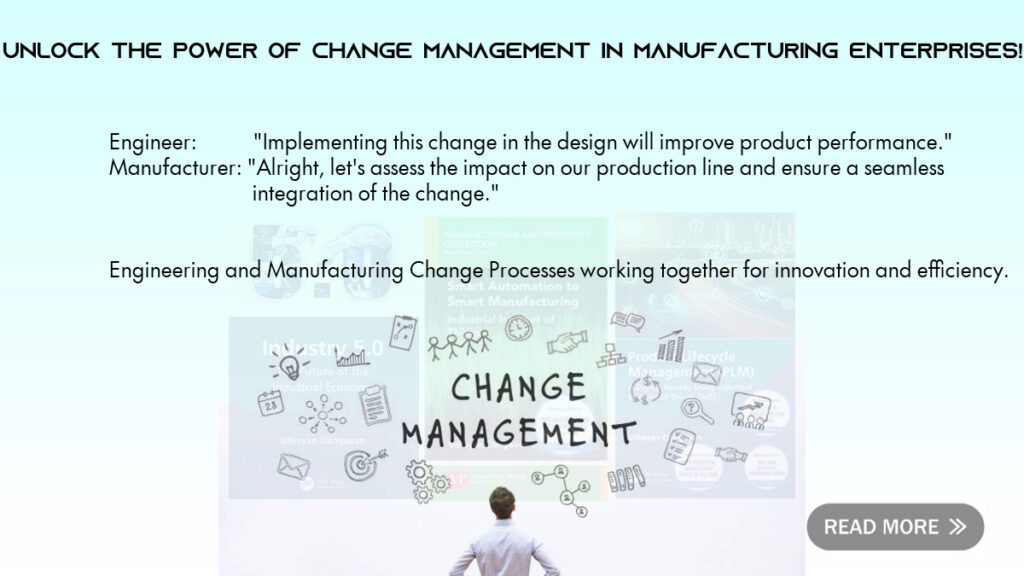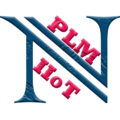Standardizing Change Management in Manufacturing: Challenges & Strategies. From coordinating diverse business units to addressing cultural differences and process variations, navigating these challenges is crucial to foster effective change management practices.

Introduction:
In the dynamic landscape of manufacturing, Change Management plays a crucial role in facilitating successful transformations within organizations. This article delves into the concepts of Change Management, specifically focusing on Engineering Change Management (ECM) and Manufacturing Change Management (MCM). We explore the challenges of standardizing Change Management across diverse business units within a manufacturing enterprise and provide insightful examples to elucidate these complexities.
Change Management Overview:
Change Management encompasses the structured approach of preparing, equipping, and supporting individuals, teams, and organizations to adopt and adapt to change effectively. Within the manufacturing domain, Change Management is vital for driving innovation, improving processes, and implementing new technologies to remain competitive in the global market.
Engineering Change Management:
ECM refers to the management of changes in product design, specifications, and engineering processes. These changes can arise due to various factors, such as customer feedback, emerging technologies, regulatory requirements, or cost optimization. ECM ensures smooth transition and integration of engineering changes into the existing product development and manufacturing processes. It involves comprehensive planning, impact analysis, and effective communication to minimize disruptions and avoid rework.
For example, consider an automotive manufacturer that receives feedback from customers about a safety issue in one of its models. ECM would involve evaluating the design, identifying necessary modifications, assessing the impact on cost and manufacturing, and effectively implementing the changes across the entire production line. A well-executed ECM process ensures product quality, regulatory compliance, and customer satisfaction.
Manufacturing Change Management:
MCM focuses on managing changes in the manufacturing processes, equipment, and systems. These changes are driven by factors such as process optimization, new technologies, capacity expansion, or supply chain modifications. MCM aims to streamline operations, enhance productivity, and achieve cost efficiencies while maintaining product quality and customer satisfaction.
For instance, consider a pharmaceutical company that decides to implement a new manufacturing technology to increase production capacity. MCM would involve evaluating the impact of the technology on existing processes, training the workforce, modifying equipment, and ensuring seamless integration of the new system into the manufacturing operations. MCM ensures that changes are effectively communicated, planned, and executed to minimize downtime and disruptions to production.
Standardization Challenges within Manufacturing Enterprises:
Standardizing Change Management across diverse business units within a manufacturing enterprise presents several practical difficulties. These challenges stem from variations in organizational culture, operational processes, resources, and the complexity of product portfolios.
- Cultural Differences: Different business units within an enterprise may have distinct cultures and mindsets regarding change. Resistance to change, lack of communication, and siloed thinking can hinder the standardization of Change Management practices.
- Process Variations: Business units often have their unique operational processes and workflows. Harmonizing these processes and aligning them with standardized Change Management practices requires significant effort and coordination.
- Resource Constraints: Manufacturing enterprises typically have limited resources, including budget, manpower, and time. Allocating resources uniformly across diverse business units can be challenging, impacting the consistency and effectiveness of Change Management practices.
- Product Complexity: Manufacturing enterprises often have diverse product portfolios with different levels of complexity. Standardizing Change Management becomes intricate when dealing with products that vary in size, technology, and regulatory requirements.
For instance, an aerospace manufacturer may have business units producing commercial aircraft, military jets, and satellite systems. Each unit may require specific Change Management approaches due to the unique characteristics of the products.
Standardizing Change Management Processes:
- Develop a Common Change Management Framework:
- Establish a standardized Change Management framework that encompasses key principles, processes, and tools.
- Define clear roles and responsibilities for Change Management stakeholders across business units.
- Ensure consistent documentation and communication channels for change requests and approvals.
- Implement Enterprise-wide Change Management Training:
- Conduct comprehensive training programs to educate employees on the standardized Change Management processes.
- Foster a culture of change readiness and continuous improvement across all business units.
- Provide ongoing support and resources for employees to enhance their Change Management capabilities.
- Establish a Centralized Change Management Team:
- Create a dedicated Change Management team responsible for overseeing and facilitating change initiatives.
- This team should ensure consistency in change assessment, impact analysis, and implementation across the enterprise.
- Facilitate knowledge sharing and collaboration between business units to leverage best practices and lessons learned.
Risk and Mitigation:
Risk: Resistance to Change
Mitigation:
- Implement robust change communication strategies to address concerns, highlight benefits, and foster employee engagement.
- Involve key stakeholders early in the change process to gain their support and involvement.
- Provide adequate training and support to employees to build their change resilience and mitigate resistance.
Risk: Process Variations
Mitigation:
- Conduct a thorough assessment of existing processes and identify commonalities to build a standardized framework.
- Collaborate with representatives from different business units to understand their specific requirements and incorporate flexibility where necessary.
- Regularly review and update the standardized processes based on feedback and evolving business needs.
Risk: Resource Constraints
Mitigation:
- Prioritize Change Management resources based on the criticality and impact of changes.
- Seek cross-functional collaboration and resource sharing between business units.
- Invest in automation and digital tools to streamline Change Management processes and optimize resource allocation.
By implementing these strategies and addressing the associated risks, manufacturing enterprises can move closer to standardizing Change Management practices, fostering collaboration, and driving transformative change across diverse business units.
How Product Lifecycle Management (PLM) Adds Value to ECM and MCM Processes:
PLM plays a vital role in enhancing the effectiveness and efficiency of Engineering Change Management (ECM) and Manufacturing Change Management (MCM) processes, adding significant value to manufacturing enterprises.
PLM streamlines the ECM process by:
- Centralizing product data: PLM serves as a single source of truth, housing all product-related information, including design files, specifications, and change history. This enables efficient change tracking and ensures accurate data availability during the ECM process.
- Enabling collaboration: PLM facilitates cross-functional collaboration by providing a collaborative platform for stakeholders to review, discuss, and approve engineering changes. This streamlines communication, reduces errors, and accelerates decision-making.
- Automating change workflows: PLM automates change workflows, ensuring that change requests are routed to the right individuals for review and approval. This minimizes manual errors, eliminates bottlenecks, and speeds up the overall ECM process.
OpenBOM PLM Change Process for SMEs:
OpenBOM PLM offers a tailored Change Management process for small and medium-sized enterprises (SMEs), aiding their growth and competitiveness. OpenBOM‘s Change Management capabilities provide SMEs with:
- Simplified change tracking: OpenBOM enables SMEs to track and manage engineering changes in a user-friendly and intuitive interface. This ensures transparency and traceability throughout the change process.
- Collaboration and visibility: OpenBOM promotes collaboration by allowing multiple stakeholders to access and contribute to change discussions and decisions. SMEs can enhance communication, engage stakeholders, and make informed decisions.
- Scalable and affordable solution: OpenBOM’s cloud-based PLM platform offers SMEs a cost-effective solution with scalable features, ensuring that they can effectively manage their change processes without the burden of high upfront costs.
PTC Windchill PLM Change Process for Discrete Manufacturers:
PTC Windchill PLM provides comprehensive Change Management capabilities tailored to the needs of discrete manufacturers. It offers:
- Robust change impact analysis: Windchill enables manufacturers to conduct thorough impact analysis to understand the effects of proposed changes on product design, manufacturing, and downstream processes. This ensures better decision-making and minimizes risks.
- Change synchronization across systems: Windchill facilitates seamless synchronization of change information with other enterprise systems, such as ERP and MES, ensuring data consistency and eliminating manual data entry.
- Regulatory compliance: Windchill assists manufacturers in adhering to regulatory requirements by providing traceability and documentation of change processes, including audits, approvals, and certifications.
Conclusion:
In conclusion, Change Management serves as the catalyst for innovation and improvement within manufacturing enterprises. The dynamic nature of the industry necessitates the standardization of Engineering Change Management and Manufacturing Change Management processes. However, achieving this standardization across diverse business units poses practical challenges. Cultural differences, process variations, resource constraints, and product complexity all contribute to the complexity of standardizing Change Management practices.
To address these challenges, organizations can take proactive measures. Implementing a common Change Management framework, providing enterprise-wide training, and establishing a centralized Change Management team are essential steps towards standardization. Additionally, mitigating risks such as resistance to change, process variations, and resource constraints requires effective communication, collaboration, and allocation of resources.
By embracing these strategies, manufacturing enterprises can empower themselves to navigate the complexities of Change Management and embrace transformative change. The harmonization of processes, alignment of cultures, and optimization of resources will pave the way for standardized Change Management practices, ultimately driving sustained success in a competitive manufacturing landscape.
Transform your business with Neel SMARTEC PLM Business Consulting Services. Contact us today to schedule a consultation and propel your manufacturing enterprise towards success.


